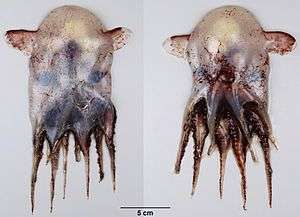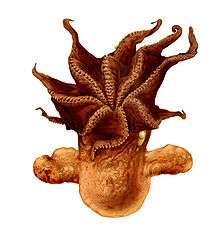Grimpoteuthis
| Grimpoteuthis | |
|---|---|
 | |
| Grimpoteuthis discoveryi | |
| Scientific classification | |
| Kingdom: | Animalia |
| Phylum: | Mollusca |
| Class: | Cephalopoda |
| Order: | Octopoda |
| Family: | Opisthoteuthidae |
| Genus: | Grimpoteuthis Robson, 1932 |
| Species | |
|
14, see text | |
Grimpoteuthis is a genus of pelagic umbrella octopus that live in the deep sea. Prominent ear-like fins protrude from the mantle just above their lateral eyes. They have a U or V shaped shell in their mantle which gives them a bell shaped appearance. Some species are short, squat and yellow, while others resemble a jellyfish with one big brown walking shoe. Some have suckers, in addition to spines, on all 8 webbed arms while others look like a regular octopus with the addition of blue or other coloured "ears". These octopuses are commonly nicknamed "Dumbo octopuses" or "Dumbo octopods" or even " Dumboes " in reference to how the ear-like fins protruding from the top of their head-like bodies resemble the ears of Walt Disney's flying elephant Dumbo. There are at least 13 species recognized in the genus,[1] each having a different aspect from all the others. These features could be larger ears or different colours. As these animals live at the bottom of the sea they have a very small food supply. Prey include crustaceans, bivalves, worms and copepods.[2] The average life span of various Grimpoteuthis species is 3 to 5 years.

All species of Grimpoteuthis are bathyal creatures, living at extreme depths of 3,000 to 4,000 metres (9,800 to 13,100 ft) with some living up to 7,000 metres (23,000 ft) below sea level, which is the deepest of any known octopus.[3] They are some of the rarest of the Octopoda species. They have been found worldwide in the waters of New Zealand, Australia, Monterey Bay, Oregon, Philippines, Martha's Vineyard, Papua New Guinea and Azores. They can flush the transparent layer of their skin at will, and are pelagic animals, as with all other cirrate octopuses. The largest Dumbo octopus ever recorded was 1.8 metres (5.9 ft) in length and weighed 5.9 kilograms (13 lb).[4] The average size for most species is 20–30 centimetres (7.9–12 in) in length. The average weight is still undetermined.
Species

- Grimpoteuthis abyssicola, red jellyhead
- Grimpoteuthis bathynectes
- Grimpoteuthis boylei
- Grimpoteuthis challengeri
- Grimpoteuthis discoveryi
- Grimpoteuthis hippocrepium
- Grimpoteuthis innominata, small jellyhead
- Grimpoteuthis meangensis
- Grimpoteuthis megaptera
- Grimpoteuthis pacifica
- Grimpoteuthis plena
- Grimpoteuthis tuftsi
- Grimpoteuthis umbellata
- Grimpoteuthis wuelkeri – possibly same as G. umbellata or G. plena
Several species formerly classified in this genus were moved to other opisthoteuthid genera.[5]
Appearance
The most acknowledged physical feature of the Grimpoteuthis is the large ear-like fins that resemble the wing-like ears of the Disney character, Dumbo. Another noticeable feature about the Dumbo octopus is the arms. When the Grimpoteuthis swims/spreads its arms out, it forms a skirt-like shape around the animal's body. These arms classify the octopus as an umbrella octopus. The Grimpoteuthis comes in a range of different colours, including red, orange, blue and in some cases purple. Between the animal's eyes and lower down, the Grimpoteuthis has an indent where its beak sits. This beak is used for catching and eating food. Certain species of Grimpoteuthis can have 'V' or 'U' shaped shields/shells. These shields/shells are used for protection against the threats the animal faces. On average, species of Grimpoteuthis grow to about 20 centimetres in length (8 inches).[6] These animals have very large eyes: on average the eyes of these animals are 12 millimetres wide.
Range and Habitat
Species of Grimpoteuthis are assumed to have a worldwide distribution. Specimens have been found off the coast of Oregon, The Philippines, Martha's Vineyard, Azores, New Zealand, Australia, California, Papua, and New Guinea. Dumbo octopuses are among the deepest living octopuses that have been observed. They can survive in extreme depths and have been found in the range of 400 to 4,800 metres (13,000 ft). Since they are living at extreme depths they are suited for living in colder temperatures. These species occupy a variety of depths and temperatures.
Threats
Species of Grimpoteuthis face few direct threats from humans, living at depths below 3,000 metres (9,800 ft).[7] Natural predators include sharks, killer whales, tuna and predatory cephalopods.
Behavior
The genus has a distinct habit of swimming. They flap their ear-like fins to propel themselves upwards. Movement of the arms can be used to help the animal move in any direction. The arms permit the animal to crawl along the seafloor, to capture prey, lay eggs, explore, etc. Dumbos hover above the sea floor, searching for polychaete worms, pelagic copepods, isopods, amphipods, and other crustaceans for food.[8] Prey is captured by pouncing on the target, which then is swallowed whole.[3]
Breeding
Females have no distinct period for breeding. Females carry multiple eggs in various stages of maturation, suggesting that they have no optimal breeding period. Male octopuses have a separate protuberance on one of their arms that carries an encapsulated sperm packet to the female. It is hypothesized that the female can then distribute this sperm to the eggs at any given time based on environmental conditions. The females lay the eggs under small rocks or on shells in the deep ocean or can even carry them on her arms, by tucking the eggs behind the wide webbing, until she finds a safe place that would provide them with the best fitness. As with other octopuses, females do not invest any further time in the young after they hatch because once they are born they are able to defend themselves.
References
- ↑ Young, Richard. "Grimpoteuthis". Retrieved 10 May 2014.
- ↑ "Finned Deep-sea Octopuses". Marinebio. Retrieved 8 May 2014.
- 1 2 "Dumbo Octopus". Aquarium of the Pacific.
- ↑ "NOAA Researchers, Ships Participate in Census of Marine Life's Decade of Discovery" (Press release). National Oceanic and Atmospheric Administration. November 23, 2009. Retrieved May 11, 2011.
- ↑ Collins, Martin A. (2003). "The genus Grimpoteuthis (Octopoda: Grimpoteuthidae) in the north-east Atlantic, with descriptions of three new species". Zoological Journal of the Linnean Society. 139: 93–127. doi:10.1046/j.1096-3642.2003.00074.x.
- ↑ "Facts About the Dumbo Octopus". Buzzle. Retrieved 8 May 2014.
- ↑ "Grimpoteuthis, The Dumbo Octopus". Ocean Portal. Retrieved 10 May 2014.
- ↑ Collins, M.A. & R. Villaneuva. (2006). Taxonomy, ecology and behaviour of the cirrate octopods. In: Gibson, R.N., R.J.A. Atkinson & J.D.M. Gordon (eds.) Oceanography and Marine Biology: An Annual Review, Volume 44. Taylor and Francis, London. pp. 277–322.
External links
- Dumbo Octopus video at BBC